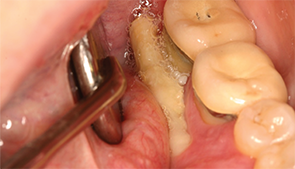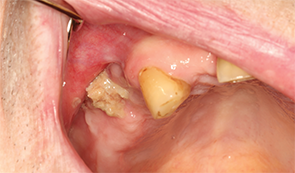Bisphosphonates are also directly toxic to epithelial cells and breakdown of mucosa (as seen in esophagitis).14 In the oral mucosa, this may lead to bacterial ingress (with Fusobacterium nucleatum, a periodontal disease pathogen, playing an important role) and colonization, inflammation and subsequent bone necrosis.15 Animal models have shown that the epithelium is injured and soft tissue healing is poor.14,16,17 Clinical studies have also shown impaired wound healing after dental extractions.18 This theory, based on mucosal breakdown and subsequent damage to, and necrosis of, the underlying bone, is sometimes termed the Outside-In theory.

Figure 2: Spontaneous
necrosis of the
mylohyoid ridge.
Other adverse effects associated with the use of bisphosphonates include gastrointestinal upset, acute-phase reactions, renal toxicity (primarily with use of intravenous bisphosphonates), and atypical fractures involving sites not usually seen in osteoporosis and stress fractures.19
Other medications have been implicated in the development of MRONJ, such as denosumab, a fully humanized monoclonal antibody used as an alternative medication to bisphosphonates.20,21 Denosumab binds to the receptor activator of NFkB ligand (RANKL), preventing activation of RANK and inhibition of maturation of pre-osteoclasts to osteoclasts.22 Compared with bisphosphonates, which have a half-life of approximately 10 years, denusamab has a half-life of 25–32 days.
Anti-angiogenic agents, such as anti-VEGF prescribed for the management of metastatic cancers, but also essential for bone remodeling and wound repair, are also associated with an increased risk of MRONJ.6,23 Anti-VEGF agents include small molecule tyrosine kinase inhibitors (TKIs), such as sunitinib, that block the VEGF receptor, and monoclonal antibodies, such as bevacizumab, that bind to VEGF and reduce its biological activity.24 Both agents are used to treat patients with metastatic solid tumors, and both have been shown to cause MRONJ independent of use of anti-resorptive agents.25-27
Although two case reports have suggested that MRONJ developed in patients treated with everolimus (an mTOR [mammalian target of rapamycin] inhibitor), both cases had also been previously treated with zoledronic acid and no cases of MRONJ caused by mTOR inhibitors alone have been reported.28,29 As such, a causal role of mTOR inhibitors and development of MRONJ is not established at this time.
MRONJ is seen in only a small percentage of patients receiving these medications, and this may be a result of genetic differences. In a large, genome-wide association study, four single nucleotide polymorphisms (SNPs) were significantly correlated with the incidence of MRONJ, namely rs1934951, rs1934980, rs1341162 and rs17110453.


